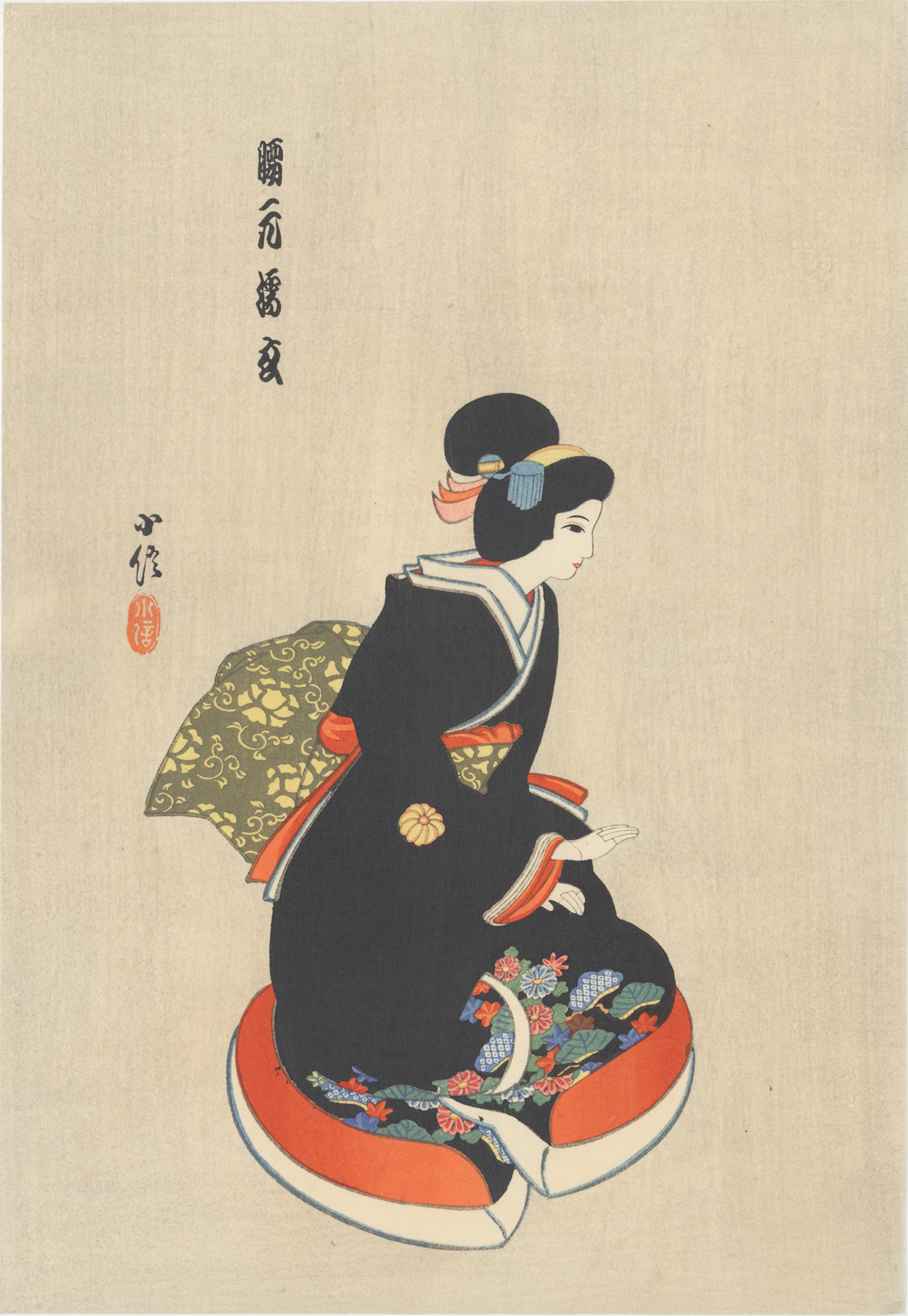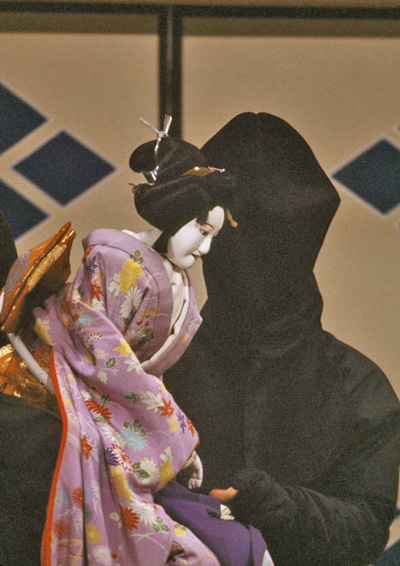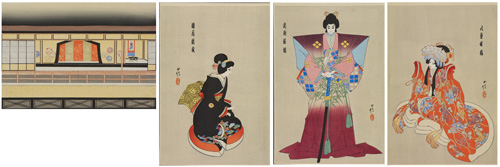About This Print
Picturing the puppet character Koshimoto Nureginu, maid to Yaegaki Hime.Brief Plot Summary
Source: Kabuki Encyclopedia, An English-Language Adaption of Kabuki Jiten, Samuel L. Leiter, Greenwood Press, 1979. p. 123-124 and The Kabuki Handbook, Aubrey S. & Giovanna M. Halford, Charles E. Tuttle Company, 12th printing 1981, p. 66-76.
Written in the mid 1700s for the puppet theater by Chikamatsu Hanji (1725-1783), assisted by Miyoshi Shoraku (1696-1775?) and Takeda Inaba, it was later adapted for the kabuki stage.
The very intricate plot revolves around the mid-16th century feud between the Takeda and Uesugi (called Nagao in the play) clans. The Shogun Ashikaga Yoshiteru has recently been murdered, and the heads of these two noble families have been ordered by the shogun's widow to find the murderer or forfeit the heads of their heirs, Takeda Katsuyori and Nagao Kagekatsu.
Princess Yaegaki, daughter of Uesugi (Nagao), is betrothed to Katsuyori but only knows him through a portrait. Before they can get married, Katsuyori supposedly commits suicide. The real suicide victim, however, is the husband of Yaegaki's maid Nureginu.
In the most performed scene, Jūshukō (Ten Types of Incense) Yaegaki Hime and her maid Nureginu are grieving over the death of their lovers when the gardener Minosaku (Takeda Katsuyori in disguise) appears. Yaegaki falls in love with the disguised Katsuyori (her former betrothed) and asks Nureginu to be her go-between. Katsuyori asks Yaegaki for the sacred helmet originally belonging to Takeda Shingen as a token of her love. This request reveals to Yaegaki that Minosaku is none other than Takeda Katsuyori. Katsuyori continues saying he is Minosaku and Yaegaki takes Katsuyori's sword and tries to kill herself, saying she is too ashamed of what she did to get the love of somebody who is not her betrothed. Moved by Yaegaki's faithful love, Katsuyori tells her the truth.Nagao Kenshin appears on stage and sends Minosaku away to deliver a letter, He then orders his strongest retainers, the sword-bearer Shirasuga Rokurō and the spear-holder Hara Kobunji, to kill Katsuyori. This shocks the two women who try to plead Katsuyori's cause to a relentless Kenshin. Yaegaki, Nureginu and Kenshin pose as the curtain is drawn to end the scene.
About the "Illustrated Collection of Famous Japanese Puppets of the Osaka Bunrakuza"
This collection of forty-eight color woodblock prints was designed by Hasegawa Sadanobu III (Konobu III) (1881-1963) and issued over the period March 1926 (Taishō 15) to August 1927 (Shōwa 2)1 by the publishing houses Bijutsusha 美術社 in Tokyo and on a subscription (members only) basis by Hangakai hanmoto 版画会板元 (板畫會板元) in Kyoto. The cost per print set was 3 yen. The editor and publisher for both the Bijutsusha and Hangakai hanmoto sets was Hayashi Eikichi 林榮吉, who was also the editor for Hasegawa's Collection of One Hundred Kumadori Makeups in Kabuki. (See Hasegawa Sadanobu III (Konobu III) (1881-1963) for prints from this collection.)
The Illustrated Collection of Famous Japanese Puppets of the Osaka Bunrakuza consists of twelve sets of prints each set depicting a specific play in the bunraku repertory, as listed in the below table. Each set contains a stage set for the specific play along with three prints of puppet characters appearing in the play and an explanatory sheet, for a total of forty-eight color woodblock prints and twelve monochrome explanatory sheets. Each of the stage set prints was originally issued with a tissue overlay showing the position of the three puppet characters on the stage. All of the plays pictured were performed at the Bunraku Theater (Bunraku-za) located within the Goryō Shrine compound in Osaka. The Goryō Bunraku-za burned down in November 1926 after what has been described as "an extremely difficult managerial era" and "lost interest" by the public in the late Taishō era.2 It is unknown what role, if any, the management of the Goryō Bunraku-za may have played in the formulation and issuance of this print series in their efforts to revitalize the theater.
For more complete information on this series see the article Illustrated Collection of Famous Japanese Puppets of the Osaka Bunrakuza
1 Dates are taken from the colophons on the envelopes containing the print sets in the Waseda University Archives2 National Diet Library website page http://www.ndl.go.jp/scenery/e/column/kansai/goryo_bunrakuza.html which provides a history of the Goryō Bunrakuza.
Play Name in Japanese Play Name in English 壇浦兜軍記
Dan-no-ura kabuto gunki Chronicle of the Battle of Dan-no-ura 義経千本桜
Yoshitsune senbon zakura Yoshitsune and the Thousand Cherry Trees 一の谷嫩軍記
Ichi-no-tani futaba gunki Chronicle of the Battle of Ichinotani 仮名手本忠臣蔵、五段目
Kanadehon Chūshingura, go danme The Treasury of Loyal Retainers, Act 5 仮名手本忠臣蔵、七段目
Kanadehon Chūshingura, shichi danme The Treasury of Loyal Retainers, Act 7 伊賀越道中双六
Igagoe dōchū sugoroku The Revenge at Igagoe 心中天網嶋
Shinjū ten no amajima The Love Suicides at Amijima 新版歌祭文
Shinpan Utazaimon The New Scandalous Ballad of Osome and Hisamatsu 菅原伝授手習鑑
Sugawara Denju Tenarai Kagami Sugawara and the Secrets of Calligraphy 本朝廿四孝
Honchō nijūshikō Twenty-four Examples of Filial Piety 鎌倉三代記
Kamakura sandaiki Three Generations of Kamakura Shoguns 夏祭浪花鑑
Natsumatsuri Naniwa kagami Summer festival at Naniwa (Osaka)
| Play Name in Japanese | Play Name in English |
| 壇浦兜軍記 Dan-no-ura kabuto gunki | Chronicle of the Battle of Dan-no-ura |
| 義経千本桜 Yoshitsune senbon zakura | Yoshitsune and the Thousand Cherry Trees |
| 一の谷嫩軍記 Ichi-no-tani futaba gunki | Chronicle of the Battle of Ichinotani |
| 仮名手本忠臣蔵、五段目 Kanadehon Chūshingura, go danme | The Treasury of Loyal Retainers, Act 5 |
| 仮名手本忠臣蔵、七段目 Kanadehon Chūshingura, shichi danme | The Treasury of Loyal Retainers, Act 7 |
| 伊賀越道中双六 Igagoe dōchū sugoroku | The Revenge at Igagoe |
| 心中天網嶋 Shinjū ten no amajima | The Love Suicides at Amijima |
| 新版歌祭文 Shinpan Utazaimon | The New Scandalous Ballad of Osome and Hisamatsu |
| 菅原伝授手習鑑 Sugawara Denju Tenarai Kagami | Sugawara and the Secrets of Calligraphy |
| 本朝廿四孝 Honchō nijūshikō | Twenty-four Examples of Filial Piety |
| 鎌倉三代記 Kamakura sandaiki | Three Generations of Kamakura Shoguns |
| 夏祭浪花鑑 Natsumatsuri Naniwa kagami | Summer festival at Naniwa (Osaka) |
Print Details
| IHL Catalog | #2477 |
| Title or Description | Koshimoto Nureginu in Honchō nijūshikō [Twenty-Four Examples of Filial Piety] Bunraku ningyō Koshimoto Nureginu, Honchō nijūshikō 文楽人形 本朝廿四孝 腰元濡衣 Note: Also translated as Twenty-Four Dutiful Sons; Twenty-Four Examples of Filial Piety; Twenty-Four Paragons of Filial Piety. |
| Series | Illustrated Collection of the Famous Japanese Puppets of the Osaka Bunrakuza Ōsaka Bunraku-za Ningyō Gashū: Nihon Meibutsu 日本名物大阪文楽座人形画集 |
| Artist | Hasegawa Sadanobu III (Konobu III) (1881-1963) |
| Signature |  小信 Konobu 小信 Konobu |
| Seal | 小信 Konobu (see above) |
| Publication Date | Taishō 15 or Shōwa 2 (1926 or 1927) |
| Publisher | 美術社 Bijutsusha, Tokyo and 版画会板元 Hangakai hanmoto, Kyoto |
| Carver | 佐藤重一 Satō Jūichi |
| Printer | 板垣八重松 Itagaki Yaematsu |
| Impression | excellent |
| Colors | excellent |
| Condition | excellent |
| Genre | 文楽人形 bunraku ningyō |
| Miscellaneous | |
| Format | |
| H x W Paper | 14 7/16 x 9 7/8 in. (36.7 x 25.1 cm) |
| H x W Image | 14 7/16 x 9 7/8 in. (36.7 x 25.1 cm) |
| Literature | |
| Collections This Print | Waseda University Cultural Resource Database 201-1549; Ritsumeikan University Art Research Center AcNo. arcBK06-002_45; National Diet Library Call Number 414.38; The Met Thomas J. Watson Library 240.3081 H27 Quarto; British Library System number: 018894603 |





